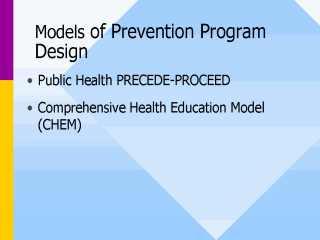| front |1 |2 |3 |4 |5 |6 |7 |8 |9 |10 |11 |12 |13 |14 |15 |16 |17 |18 |19 |20 |review |
 |
Models of
Prevention Program Design: Prevention programs require attention to the communication
outcomes that the speech-language pathologist or audiologist wishes to change. Two models
of prevention from health education are: A. Public Health Model PRECEDE-PROCEED: PRECEDE and PROCEED are acronyms for public health models that describe a health promotion-planning framework. PRECEDE stands for attitudes or actions which are predisposing (Doctors make you well, go to one when you are sick), reinforcing (all your friends smoke marijuana, you smoke marijuana), and enabling (access of health resources) constructs in educational/environmental diagnosis and evaluation. PROCEED stands for policy (What current policies would support a prevention effort?) , regulatory, and organizational constructs in educational and environmental development (Do your children believe they can change behaviors that contribute to their disorder?). B. Comprehensive health education model (CHEM): Consists of six steps with specified procedures. 1) Involve people (ID target population and persons required to carry out the program), 2) Set goals (appropriate for the program), 3) Define problems (What are the health gaps and what will be the focus of the program), 4) Design plans (creation of activities, program objectives, resources needed and evaluation plan), 5) Conduct activities; 6) Evaluate results. Transition Point: It is important to have clear program objectives and initiatives when designing a prevention program... |